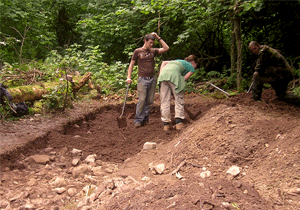GGAT Dig Diary-Church Hill
The Church Hill Enclosure Excavation and Survey Project was carried out jointly by the Glamorgan-Gwent Archaeological Trust, the Department of Classics, Ancient History and Egyptology at Swansea University and the Royal Institution of South Wales, with grant aid from Cadw. The fieldwork part of the project ran for two weeks in early July 2008. The aim of the survey was to make a detailed record of the enclosure as it exists today. The excavation was designed to find out more about the site, particularly about how the Roman finds related to the enclosure, and to see whether the modern track running over the site had done any serious damage to the archaeology.
The excavation found that the stone bank surrounding the enclosure contained Roman pottery and tile. It is therefore more recent than the start of the Roman occupation, and may indeed date to the period between the Romans and Normans. Although modern vehicles on the track had made ruts in the surface of the bank, on the whole it had not been badly damaged.
The excavation also discovered the remains of a wall outside of the enclosure. This appeared just under the modern ground surface, but little more than the foundations survived. This feature was probably part of a building, but no other walls belonging to it were found during the excavation.
The fieldwork was carried out mainly by students from the university, most of whom had never had the opportunity to do work like this before. They were supervised and trained by their head of department and Trust staff. Read the day-to-day dig diary kept by one of the postgraduate students, Jo Edwards.
Click on the images to enlarge
Excavation Team
Excavation team members: Eddie (Head of Classics Department, Swansea University), Edith (Outreach and Heritage Manager-GGAT Curatorial), Rowena (Project Officer-GGAT Projects), Tracey (Classics lecturer, Swansea University), Rachel, Lauren, Emily, Fran, Becky, Hannah, Ben, Sean, Jerrad, Jo, Ken, Meg, Lee, and Bob. Bernice (Royal Institution of South Wales) came one day each week to wash finds.
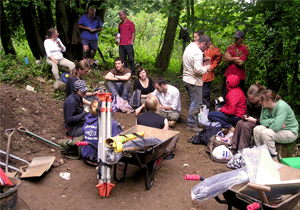
Week 1
Day 1-Monday 30th June 2008
On the first day of the excavation we installed the two cabins and the porterloo,unloaded all the digging equipment into one of the cabins and the vital tea making equipment into the other. Before walking up the hill to see the site itself we had a look round the locality. This included a Neolithic burial chamber, a large cave, and a limekiln. It was clear that the general area had been occupied since prehistory.
After lunch we walked up the hill to the site itself. We had expected it to be clear of undergrowth but alas it was not. We spent the rest of the day clearing nettles and brambles and getting numerous stings, scratches and blisters.
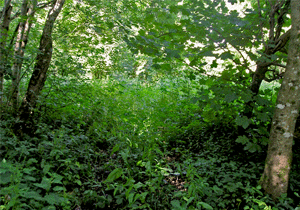
Day 2-Tuesday 1st July
We continued clearing the site until we had enough space to lay out the two trenches. Without the undergrowth it was a little easier to see the remains and we were able to trace the stones which formed an enclosure wall. We decided to have two trenches, one across the wall and one outside the wall, as many of the finds so far were discovered outside this enclosure wall. We measured out the 2x19m (it was meant to be 20m but there wasn't quite enough room) trench 1 outside the enclosure wall and the 2x10m trench 2 across the wall itself. After the trenches were laid out and we had a master class in technique, we began mattocking to clear the topsoil. This was very hard work!
This was also the day when we discovered the delights of instant tea!

Day 3-Wednesday 2nd July
Row began her survey work today as most of the clearing had been finished. She explained that we put the post in the ground first and then locate the laser second. After attempting this for over an hour with no success, we gave up and hammered the post in the ground underneath the tripod. Row explained that she made it difficult for us on purpose to make us learn quicker.
The top layer of trench 1 was almost removed, good mattocking work! Trench 2 had also made good progress. Half of the trench had been cleared by mattocks and the stone wall in the centre had been trowelled.
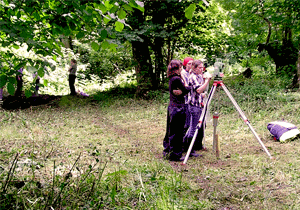
Day 4-Thursday 3rd July
It had rained heavily overnight so we began the day by clearing the trenches of rain and mud from the night before.
In trench 1 we found what appeared to be a wall at the southern end of the trench. By this wall, a fragment of copper alloy was found, the first serious find of the excavation! The rest of the top layer was cleared and we had begun to remove the second layer, also by mattocking.
Trench 2 revealed some good finds also. Some Samian ware had been found along with many fragments of terracotta tile. There was also a small cache of animal bone and oyster shells.
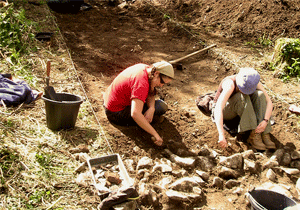
Day 5-Friday 4th July
Trench 2 was finished and photographs could be taken. After the photographs had been taken, the trench could be drawn. I had decided to take on this task. I hadn't realised how many stones there were!
Trench 1 had more clearing of stones by trowelling. A decorated tile had been found, also at the southern end of the trench, possibly a flu tile as well as a large fragment of a pot base.
Lots of surveying was done.
Trench 3 was opened. 2x10m and placed inside the closure wall. On mattocking the first level of topsoil, already we had found some Samian ware and some large stones in a line at the northern end of the trench.
As a token to the American members of the dig (Jerrad and Meg) we decided to go to the pub after the dig to celebrate Independence Day. A good time was had by all. Apart from Eddie who didn't turn up.
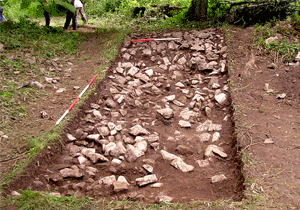
Week 2
Day 6-Monday 7th July
Today mainly consisted of trowelling trenches 1 and 3 to clear more stones. The drawing of trench 2 also continued.
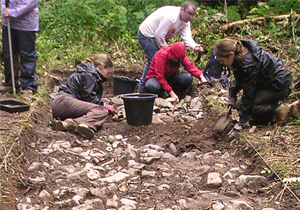
Day 7-Tuesday 8th July
More clearing of trenches 1 and 3. More drawing of trench 2.
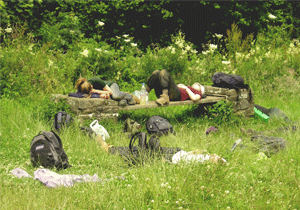
Day 8-Wednesday 9th July
The forecast for today was heavy rain all day, and it had rained heavily the night before. We arrived at the site and did not get ready too fast as we were not sure whether it was worth going up the site or not. When everyone had arrived we decided to go up the path to have a look just in case it stopped. It did not. We spent most of the morning trampling down more undergrowth so we could survey the topography of the site further, and attempting to clear some more mud (mud being the operative word) from the stones in trench 1. Everyone was soaked to the skin (through their waterproofs) before we even got to the top of the path. By the time it got to morning break (11am) we were thoroughly miserable and a bit dubious about getting back down the path. We continued to work after morning break but we ended up covering up stones with more mud than we were removing. We gave up at 11:30am and attempted to make our way down the path to go home. Only 4 people fell on the way down (including Eddie)!
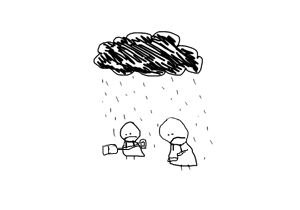
Day 9-Thursday 10th July
We spent most of the morning clearing the pooled water and liquid mud from the day and night before. The rain continued for the morning but after an early munch, it cleared to sunshine in the afternoon. There was more clearing of trenches 1 and 3. Trench 2 was still being drawn. The southern end of trench 1 was cleared enough for drawing, and Ken and Jerrad began the task of recording all the stones. Trench 3 was still being cleared. This was very hard going, as the soil was mainly heavy clay.
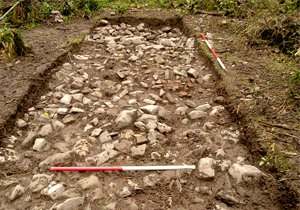
Day 10-Friday 11th July
Ken finished his section of the trench 1 drawing. Jerrad continued his section of the trench then passed the task onto Becky mid morning. The northern end of trench 1 was still being cleared, as was trench 3. At long last, the drawing of trench was final complete after a long and technical effort by my assistant (Meg) and myself. It was a relief to be finished.

Week 3 (final week)
Day 11-Monday 14th July
On arrival to the site on Monday morning, we realised that the porterloo has not been serviced since it was delivered; it had become rather wiffy!
We had a few less members to our team today as it was graduation for the third years (Ben, Fran, Rachel, Lauren).
As the southern end of trench 1 had already been photographed and drawn, we were able to remove the stone in that layer to see what may lie underneath. It was mainly Ken who took on this task the help of one or two others. This new level revealed some large fragments of pot, more terracotta tile pieces, some bone fragments, and what appeared to be a general burnt area of ground.
Today we had a new member to our team, Bob Dean who began work removing the stones from either side of the wall in trench 2 with Tracey and me. This was to determine to extent of the wall and how it was constructed. At the base of this wall on the southern side, Bob continued to excavate to see if the wall went any further, and found what seemed to be a pit containing oyster shells and bone fragments.
In the afternoon, trench 3 was completely cleared and it was photographed and I was given the task of drawing the revealed stones, which included a cobbled surface.

Day 12-Tuesday 15th July
Today was the day of the Egyptology interviews at the university so Eddie (being Head of Department) was not on site, and neither were Ken, Meg, Jerrad, or myself, as we all attended. Some other members of team also did not make it to the dig due to graduation ball preparations.
The southern end of trench 1 led by Ken continued to grow deeper with more finds coming out. Becky was now drawing the cleared northern end of trench 1. The trench 2 wall was still being cleared and the pit at the bottom of this wall was getting deeper and revealing many more oyster shells and bone fragments.

Day 13-Wednesday 16th July
By the afternoon, the drawing of trench 3 had been completed! Woohoo! The increasingly deep hole in Trench 1 was still being excavated as the archaeology was still going down.
The pits in trench 2, found by Bob, were excavated further by Bob himself and Jerrad. A further 2 buckets full of oyster shells were removed from the pit as well as other shellfish shells and many animal bone fragments.
The wall in trench 2 was fully cleared and it was decided to remove half of the wall to provide a section. After this was done, Becky (who had completed the drawing of trench 1) began the plan drawing of the remainder of the wall.
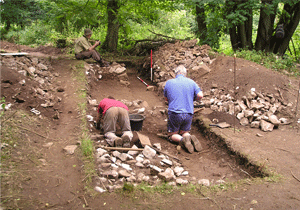
Day 14-Thursday 17th July
The deep section in trench 1 was finally at a level where we could stop and so it was photographed and drawn. In trench 2 the section of wall (or bank, we are not quite sure) was also drawn today. Much more surveying was done by the crack team of surveyors made up of myself, Meg and Row. Over 200 points recorded on one day!
The pit at the base of the wall in trench 2 was still producing a vast quantity of oyster shells and bone fragments.
Trench 3 had been fully excavated, photographed and drawn and so in the afternoon we started filling it back in. Quite depressing!
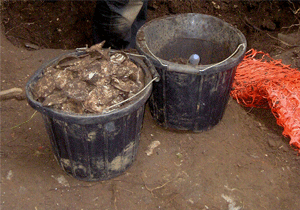
Day 15-Friday 18th July (last day)
As today was the last day we were in a bit of a rush! The drawings of trenches 1 and 2 were completed whilst the other ends of both trenches were being filled in! Unfortunately the filling back in of the trenches took longer than we had anticipated so we worked solidly until 6:30pm. This was not good as we had our final day dig meal booked for 8pm so it was a close call. We all made it to the meal on time and had a nice last sociable night.
